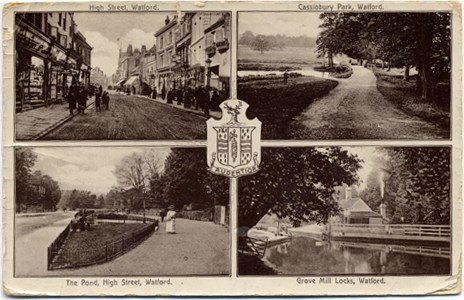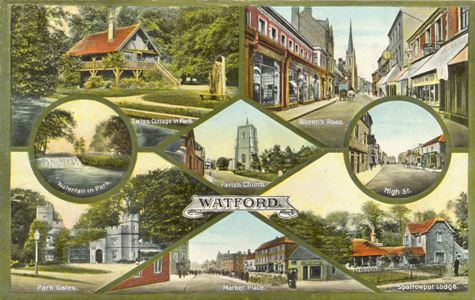
Published by
Downer & Sons. Posted 1907
|
|
Adjacent Parishes: Abbots Langley, Aldenham, Bushey, Kings Langley, Pinner (Middlesex), Rickmansworth, Ruislip (Middlesex), Sarratt, St Stephens (St Albans)
Watford is an ancient market town which developed along the main road from London to Birmingham via Aylesbury. Since the coming of the railway in 1837 Watford has grown rapidly and is now a major centre of population. For this reason the information on the town has been split up over the following pages:

Published by
The London View Co. Ltd. Posted 1906
Over the years many people have suggested various ways in which Watford got its name, and Saunders' History of Watford gives details of some of them. Chauncy suggested the name was from "Wetford" - a deep ford that wetted the users. Cussans suggested "Wadeford" because the ford was midbody deep. Others have suggested "Watlingford" because it is on a branch of Watling Street. Saunders considers the possibility that it was "Wata's Ford" after some otherwise unknown Anglo-Saxon called Wata. The Place-names of Hertfordshire records early spellings as Watford, Wetford, Wathford and Watteford and suggests that the original Anglo-Saxon name would have been something like Wathford in modern language, and meant a ford which is used by Hunters. All we know for certain is that the name dates from before the Norman conquest and its origin is speculation.

Published by H. W, Rawlings, High Street, Watford. Posted 1912
| Q. What is the situation of Watford?
A. Watford, a handsome well-built market-town, consisting chiefly of one long street, is situated on a rising hill, near the River Colne, by which it is nearly surrounded, 20 miles from Hertford and 14½ from London. It contains 519 houses and 2603 inhabitants, and has a market on Saturday. Q. What is worthy of notice in Watford? A. The church, which stands nearly in the centre of the town, is a spacious stone structure, with a lofty tower, surmounted by a spire, the summit of which is 110 feet from the ground. Within are some handsome monuments of the Morison family and of the Countess Dowager of Bedford. In the church-yard is a large and handsome school-house for 40 boys and 20 girls, founded by Mrs Elizabeth Fuller, and since assisted by the bequests of three charitable persons. Here are likewise eight alms-houses and a respectable market-house, resting on wooden pillars. Watford is the native place of the late William Kenrick. Q. Has Watford any manufactures? A. Yes; it has three large manufactories for throwing silk, and two paper mills. Q. What seats are in the vicinity of Watford? A. North-west of the town, is Cashiobury Park, the noble seat of the Earl of Essex; to the north of this is Grove Park, the residence of the Earl of Clarendon, and near it, on the east, is Russell Farm, the mansion of Lord Henley. The History and Topography of Hertfordshire, circa 1820 |

Published by Jackson & Son, Publishers, Grimsby. Posted 1912
See also Vital Records
Page updated October 2008